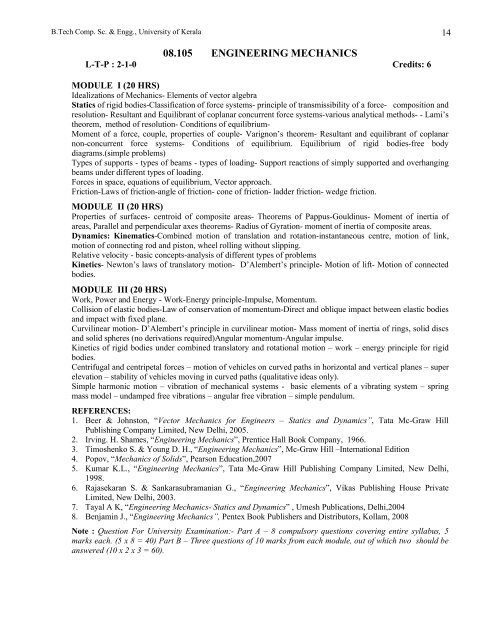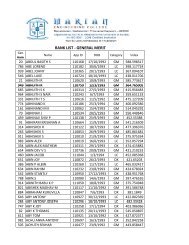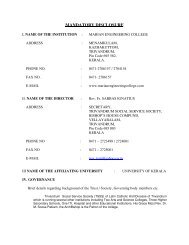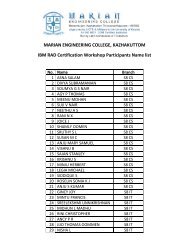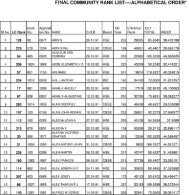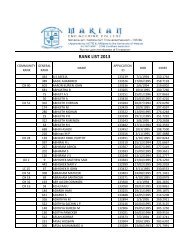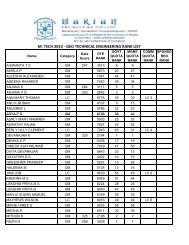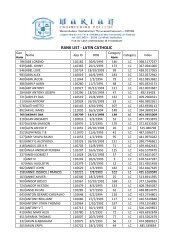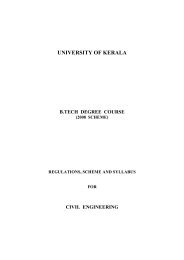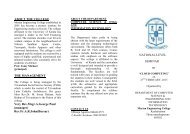UNIVERSITY OF KERALA - Marian Engineering College
UNIVERSITY OF KERALA - Marian Engineering College
UNIVERSITY OF KERALA - Marian Engineering College
Create successful ePaper yourself
Turn your PDF publications into a flip-book with our unique Google optimized e-Paper software.
B.Tech Comp. Sc. & Engg., University of Kerala 14<br />
08.105 ENGINEERING MECHANICS<br />
L-T-P : 2-1-0 Credits: 6<br />
MODULE I (20 HRS)<br />
Idealizations of Mechanics- Elements of vector algebra<br />
Statics of rigid bodies-Classification of force systems- principle of transmissibility of a force- composition and<br />
resolution- Resultant and Equilibrant of coplanar concurrent force systems-various analytical methods- - Lami’s<br />
theorem, method of resolution- Conditions of equilibrium-<br />
Moment of a force, couple, properties of couple- Varignon’s theorem- Resultant and equilibrant of coplanar<br />
non-concurrent force systems- Conditions of equilibrium. Equilibrium of rigid bodies-free body<br />
diagrams.(simple problems)<br />
Types of supports - types of beams - types of loading- Support reactions of simply supported and overhanging<br />
beams under different types of loading.<br />
Forces in space, equations of equilibrium, Vector approach.<br />
Friction-Laws of friction-angle of friction- cone of friction- ladder friction- wedge friction.<br />
MODULE II (20 HRS)<br />
Properties of surfaces- centroid of composite areas- Theorems of Pappus-Gouldinus- Moment of inertia of<br />
areas, Parallel and perpendicular axes theorems- Radius of Gyration- moment of inertia of composite areas.<br />
Dynamics: Kinematics-Combined motion of translation and rotation-instantaneous centre, motion of link,<br />
motion of connecting rod and piston, wheel rolling without slipping.<br />
Relative velocity - basic concepts-analysis of different types of problems<br />
Kinetics- Newton’s laws of translatory motion- D’Alembert’s principle- Motion of lift- Motion of connected<br />
bodies.<br />
MODULE III (20 HRS)<br />
Work, Power and Energy - Work-Energy principle-Impulse, Momentum.<br />
Collision of elastic bodies-Law of conservation of momentum-Direct and oblique impact between elastic bodies<br />
and impact with fixed plane.<br />
Curvilinear motion- D’Alembert’s principle in curvilinear motion- Mass moment of inertia of rings, solid discs<br />
and solid spheres (no derivations required)Angular momentum-Angular impulse.<br />
Kinetics of rigid bodies under combined translatory and rotational motion – work – energy principle for rigid<br />
bodies.<br />
Centrifugal and centripetal forces – motion of vehicles on curved paths in horizontal and vertical planes – super<br />
elevation – stability of vehicles moving in curved paths (qualitative ideas only).<br />
Simple harmonic motion – vibration of mechanical systems - basic elements of a vibrating system – spring<br />
mass model – undamped free vibrations – angular free vibration – simple pendulum.<br />
REFERENCES:<br />
1. Beer & Johnston, “Vector Mechanics for Engineers – Statics and Dynamics”, Tata Mc-Graw Hill<br />
Publishing Company Limited, New Delhi, 2005.<br />
2. Irving. H. Shames, “<strong>Engineering</strong> Mechanics”, Prentice Hall Book Company, 1966.<br />
3. Timoshenko S. & Young D. H., “<strong>Engineering</strong> Mechanics”, Mc-Graw Hill –International Edition<br />
4. Popov, “Mechanics of Solids”, Pearson Education,2007<br />
5. Kumar K.L., “<strong>Engineering</strong> Mechanics”, Tata Mc-Graw Hill Publishing Company Limited, New Delhi,<br />
1998.<br />
6. Rajasekaran S. & Sankarasubramanian G., “<strong>Engineering</strong> Mechanics”, Vikas Publishing House Private<br />
Limited, New Delhi, 2003.<br />
7. Tayal A K, “<strong>Engineering</strong> Mechanics- Statics and Dynamics” , Umesh Publications, Delhi,2004<br />
8. Benjamin J., “<strong>Engineering</strong> Mechanics”, Pentex Book Publishers and Distributors, Kollam, 2008<br />
Note : Question For University Examination:- Part A – 8 compulsory questions covering entire syllabus, 5<br />
marks each. (5 x 8 = 40) Part B – Three questions of 10 marks from each module, out of which two should be<br />
answered (10 x 2 x 3 = 60).


